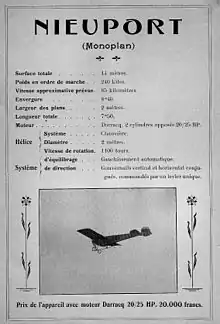Nieuport II
The Nieuport II was a mid wing monoplane racing or sport aircraft built by the Société Anonyme des Établissements Nieuport between 1910 and 1914 and was noted for its high performance using a small twin-cylinder engine, and winning many races, primarily in France before being used as a trainer during World War One by French flying schools.
| Nieuport II | |
|---|---|
 | |
| Surviving late production Nieuport II.N at the Musée de l'Air et de l'Espace | |
| Role | Sport aircraft/Racer |
| National origin | France |
| Manufacturer | Nieuport |
| First flight | 1910 |
| Produced | 1910-1914 |
Background
Édouard Nieuport was the owner of a small company which produced spark plugs and magnetos for the automobile industry, and he became involved with aviation through working on the electrical equipment of Henri Farman's Voisin biplane. In 1908 he started constructing his first aircraft, a small monoplane powered by a 20 hp (15 kW) Darracq engine and succeeded in making some brief straight-line flights in it during 1909, but the aircraft, along with many others, was destroyed in the floods which struck Paris in January 1910.[1]
Development & Design

The Nieuport II was the subject of extensive research carried out by the Nieuport brothers in conjunction with the Eiffel Laboratories and benefitted from input from Robert Esnault-Pelterie, who had designed his own low-drag monoplane. The result was a wire-braced monoplane with only a single pair of bracing wires on each side, supplemented with a single pair of control wires to warp the wings for lateral control. The airfoil section was unusual in having a fairly thick (for the period), but sharp leading edge, with the undersides rising up to thin the airfoil out over the majority of the chord. The upper wires led to a pyramidal cabane and the pilot was nearly fully enclosed in the fuselage, with only his head exposed. Initially the undercarriage consisted of a single central skid attached to the fuselage by two inverted V struts, bearing a transverse leaf spring with a wheel on each end. When first flown the tail surfaces consisted of a semicircular horizontal stabiliser mounted on top of the rear of the fuselage, behind which was a universally-jointed assembly combining a rectangular elevator with a pair of rudders. The controls used the joystick to provide yaw (rudder) and pitch (elevator) control, while foot pedals operated the wing warping for lateral control, the pedals moving a torque tube which ran diagonally backwards to the rear v-strut of the undercarriage, where the warping wires were attached. Late examples were available with the modern arrangement as a factory option, using the pedals to control the rudder, as was used on the contemporary Blériot and Deperdussin aircraft. A variety of engines were used, starting with the Darracq, which, despite being developed specifically for Nieuport, proved unsatisfactory, and a variety of engines were tried before the Nieuport brothers developed their own twin-cylinder, horizontally-opposed engine.
Operational history

On 11 May Nieuport succeeded in breaking the world speed record for all distances up to 100 km flying a Nieuport II powered by a 28 hp (21 kW) Nieuport engine. His highest recorded speed was 119.63 km/h (74.33 mph)[2]
Three were flown in the 1911 Gordon Bennett Trophy at Eastchurch: one, flown by Charles Weymann and powered by a 100 hp (75 kW) Gnome double Omega, won the competition with a speed of 126.67 km/h (78.71 mph); a second, powered by a 70 hp (52 kW) Gnome Lambda and flown by Edouard Nieuport, placed third: the third, flown by M Chevalier and powered by a 28 hp (21 kW) Nieuport engine, failed to finish.[3]
Variants
- II.D
- 18 hp twin-cylinder horizontally opposed Darraq 25hp O-2 engine
- II.A
- 40 hp fan type Anzani engine
- II.G
- Gnome rotary engines, of 50, 70 0r 100 hp
- II.N
- 28 hp twin-cylinder horizontally opposed Nieuport engine.
- II.H
- Floatplane variant (offered but not built)
Operators
Most examples were used by individuals, however a small number were purchased by military air arms including:
- Aéronautique Militaire
- Used for flight training, including as a flightless ground trainer commonly known as a Penguin.
- Royal Siamese Air Service
- First aircraft of Royal Siamese Air Force
Survivors & Replicas
- late-production Nieuport II.N at the Musée de l'Air et de l'Espace, Le Bourget near Paris
- A taxi-able replica is at Old Rhinebeck Aerodrome in Poughkeepsie, New York state
Specifications (28 hp Nieuport engine)
Data from "Nieuport II N". Retrieved 21 May 2012.
General characteristics
- Crew: one
- Length: 7.15 m (23 ft 5 in)
- Wingspan: 8.65 m (28 ft 5 in)
- Height: 2.60 m (8 ft 6 in)
- Wing area: 14 m2 (150 sq ft)
- Empty weight: 240 kg (529 lb)
- Gross weight: 340 kg (750 lb)
- Powerplant: 1 × Nieuport 2-cylinder Horizontally opposed air-cooled, 21 kW (28 hp)
- Propellers: 2-bladed
Performance
- Maximum speed: 115 km/h (71 mph, 62 kn)
See also
Related development
Aircraft of comparable role, configuration, and era
Related lists
References
| Wikimedia Commons has media related to Nieuport II. |
Citations
- Opdycke 1999 p.189
- "New Speed Records"Flight 20 May 1911
- "Table of Cumulative Lap Times"Flight 8 July 1911.
- Opdycke 1999 p.190
Bibliography
- Davilla, Dr. James J. and Arthur Soltan. French Aircraft of the First World War, Flying Machines Press, Mountain View California, 1997, ISBN 0-9637110-4-0
- Kowalski, Tomasz J. Nieuport 1-27, Kagero, Lublin, 2003, ISBN 83-89088-09-6
- Opdycke, Leonard E. French Aeroplanes Before The Great War. Atglen, PA: Achiffer, 1999. ISBN 0-7643-0752-5
- Pommier, Gerard. Nieuport 1875-1911 - A biography of Edouard Nieuport, Schiffer Publishing, Atglen, PA, 2002 ISBN 0-7643-1624-9
- Rimmell, Ray. World War One Survivors, Aston Publications, Bucks, 1990, ISBN 0-946627-44-4